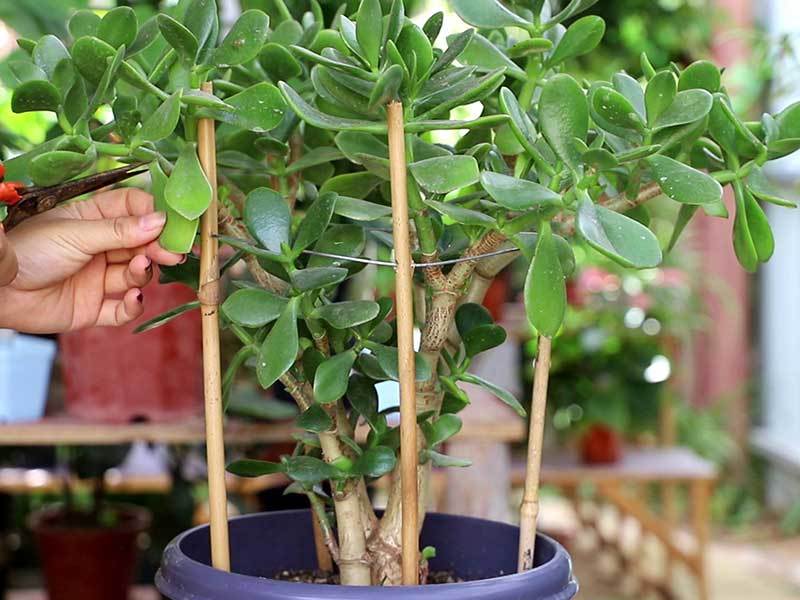Jade Plant Turning Purple: Causes and Remedies
Introduction
Jade plant leaves turning purple are your plants telling you something about their well-being. You should take some action when purple hues start to take over your jade's foliage.
Identifying Purple Discoloration
The purple hue on a jade plant's leaves can show shades from pale lavender to deep violet. Its location on the leaf can often provide a clue to the cause. The most common culprits for this jade plant leaves turning purple are changes in environmental conditions.
Some varieties of jade plants naturally display purple-tinged leaves as part of their variegation. For example, Hummel's Sunset or Pink Butterflies. Another potential reason for this change could be the plant's regular watering routine.
Why Is My Jade Plant Turning Purple?
Insufficient Sunlight
Jade plants are sun lovers by nature. In their native habitat, they're accustomed to basking in full, direct sunlight for hours on end. Indoors, however, they're at the mercy of the whims of the climate and the positioning of their caretakers.
Sunlight provides jade plants with the necessary energy to photosynthesize. When a jade isn’t getting enough light, their leaves start to stress out. One way they cope is by producing anthocyanin. This pigment can give leaves a reddish or purple sheen.
Overwatering
Another common culprit of jade plant turning purple is overwatering. These thick-leafed succulents store water for the long haul. So they're equipped to handle droughts much better than floods. However, when their roots sit in damp soil for too long, they become susceptible to rot.
With rot sets in, the plant can no longer uptake water and nutrients properly. Nutrient deficiency often results in jade plant leaves turning purple, specifically a lack of phosphorus. Without corrective action, overwatering can lead to the demise of your plant.
Nutrient Deficiencies
A lack of certain critical nutrients can result in jade plant turning purple. Common culprits include an under-supply of phosphorus, or a shortage of potassium.
Phosphorus is essential for energy transfer in plants. Potassium aids in photosynthesis and regulates water uptake. Without these key players, jades may exhibit a purpling effect. Because they struggle to function optimally.

Temperature Stress
Sudden temperature changes, particularly cold spells, can disrupt a jade's internal processes. This can lead to jade turning purple. Prolonged exposure to chilly conditions can lead to a phenomenon called "cold stress acclimation". The plant switches on protective measures, often resulting in a purple hue.
Essentially, your jade goes into survival mode. While this coloring might not harm the plant per se, it's a sign to take precautions against further stress.
Solutions to Address Jade Plant Turning Purple
Adjusting Sunlight Exposure
To remedy this, ensure place your jade in a spot with plenty of indirect or a few hours of direct sunlight each day. Gradually increase its exposure to prevent further damage. They also need shaded protection from the heat of the midday sun.
If moving your plant isn’t an option, consider supplementary lighting, especially in the darker months. A simple LED grow light can provide the right spectrum of light. This ensures your jade stays green and healthy.
Proper Watering Techniques
Jade plants are succulents. They can store water in their leaves and stems. But this doesn't mean they enjoy soggy conditions. Overwatering can lead to root rot. This affects nutrient absorption and can cause leaves to turn purple.
To avoid overwatering, make sure your jade plant's soil dries out completely between watering. Stick to a schedule of about once every two to three weeks. You can also water when the soil is dry to the touch. Use a well-draining soil mix in a pot with drainage holes. This ensures water doesn't accumulate at the roots.
Fertilization
If you suspect a nutrient deficiency, consider fertilizing your jade plant. Use a balanced, slow-release fertilizer designed for succulents. Fertilizer your jade once a month during the growing season. Follow the instructions on the package carefully to avoid overfeeding.
Temperature Regulation
Keep your jade plant in an environment where the temperature remains relatively stable. Protect it from cold drafts. If outdoors, bring it inside when temperatures drop. Likewise, shelter the plant from direct exposure to heat sources. For example, radiators or vents.
Preventive Measures
Regular Maintenance
Develop a consistent care routine for your plant's general upkeep. This routine should include proper watering, regular feeding, and an occasional check for pests or diseases. Consistency in care will help keep your plant stress-free and less likely to change color.
Observation
Take the time to observe your plants regularly. Learn to recognize the early signs of stress. For example, wilting, leaf drop, or jade leaves turning purple. Early detection can help you take corrective action before the issue progresses.
Conclusion
With proper care, it can bounce back from the purple leaves. You can continue to enjoy the beauty of a thriving, green jewel in your home.

